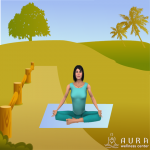In an ideal world, the idea of practicing Yoga solicits feelings of calm equipoise, energy and vibrant health. However, for many people the idea of practicing Yoga in the context of a structured class can bring up feelings of apprehension and fear. There may be any number of reasons for this apprehension. Some of these reasons include being physically or emotionally fragile. This sense of being physically fragile can come from being injured or in the process of healing from a surgical procedure.
For instance, imagine that you have recently undergone a total hip replacement surgery and this is your first time “back on the mat” in a group context. You would most likely feel very cautious about your body’s ability to safely practice most of the Yoga postures, which are routinely performed in multi-level classes. You may also have concerns about how you should modify the postures, in order to protect a vulnerable hip joint. In addition, if you are used to being quite physically agile, asking your teacher for help and slowing down during the practice may cause further anxiety, impatience, and even anger.
In the same way, if a Yoga student is feeling very emotionally fragile while he or she is traversing a difficult life event, such as a divorce or death of a loved one, engaging in vigorous Yoga postures and/or pranayama exercises may feel overwhelming. If you are a Yoga teacher, you are aware of how many of the postures and breathing exercises of Yoga can release deeply held muscular and emotional tension. When painful and difficult emotional experiences are brought to the surface through the practice of the asanas and purifying pranayama techniques, a student may be unsure how to cope with the ensuing tears or waves of anxiety.
These are only a few of the examples of fragile physical or emotional states that can make just stepping onto the mat an act of great courage for a student! As a Yoga teacher, addressing feelings of fear in your class in an accepting and straightforward manner will help your students to relax, when they realize that their anxious feelings are understood and acknowledged. There is any number of ways to address and ameliorate anxiety and fear during a Yoga class. The very first step is to set a tone of acceptance, by addressing your students at the beginning of class and letting them know that it is fine to drop into Child’s Pose if they need to rest during class.
It is also important to let your students know that you are available to assist them or offer them appropriate suggestions for modifications of classical Yoga postures; if they feel that they need to move at an individual pace. The practice of Yoga can be tailored to each individual student with the strategic use of props and modified postures. By embodying a compassionate and accepting attitude, your students will be more likely to quietly come to you and let you know if they are currently struggling with physical or emotional health issues, which need some special accommodations during the practice.
* Relaxation Breath
It is not uncommon for Yoga students to experience waves of anxiety during the practice of Shavasana or meditation. We are all so used to running in many different directions that when we slow down, anxious feelings may rise to the surface quite quickly. A very simple and effective way for calming down an overactive nervous system and quelling anxiety is to lead your students through the practice of Relaxation Breath. Essentially, this breath is comprised of elongating the exhalation in at least a 2-1 ratio to the inhalation.
The practice of Relaxation Breath can be seamlessly woven into the final portion of your Yoga class during Shavasana. It is also quite nice to practice this pranayama exercise during the beginning of a seated meditation session. If one of your students is experiencing a great deal of anxiety or emotional upset during class, you may want to suggest that he or she sit quietly in Easy Seat and practice Relaxation Breath for a period of 5 minutes or so. This simple pranayama exercise, in addition to being acknowledged and taken care, may be all a student needs to release unwanted feelings of anxiety and fear.
Virginia Iversen, M.Ed, has been practicing and studying the art of Yoga for over twenty years. She lives in Woodstock, New York; where she specializes in writing customized, search engine-optimized articles that are 100% unique. She is currently accepting Yoga and health-related writing orders and may be contacted at: enchantress108@gmail.com.
© Copyright – Virginia Iversen / Aura Wellness Center – Publications Division
See our testimonials to find out what our graduates have to say about our selection of distance learning yoga instructor certification courses.
Please feel free to share our posts with your friends, colleagues, and favorite social media networks.
Related Posts
Yoga and Progressive Relaxation Techniques
Igniting the Creative Spark with Yoga: Skull Shining Breath
Research About Pranayama for Anxiety
Common Pranayama Techniques for a Yoga Class
Pranayama Exercises for Trauma Survivors
Teaching Yoga: Pranayama for Heart Health


When students realize that their anxious feelings are understood and acknowledged then the class can be effective by addressing fear. Thanks for nice sharing!
Healthy and good for us! Anyone who wishes to perform pranayama can do this. 🙂